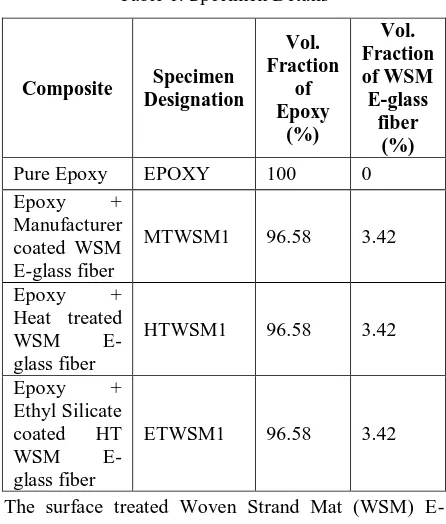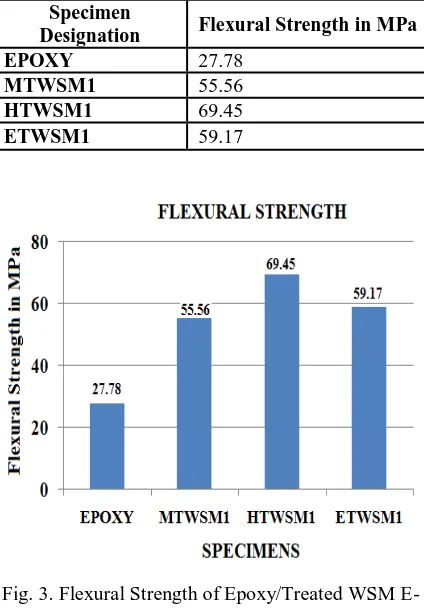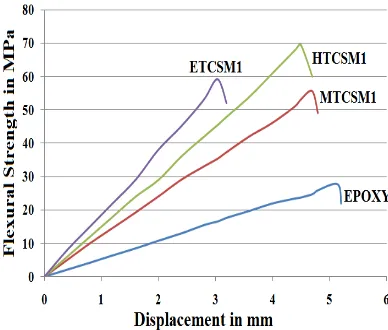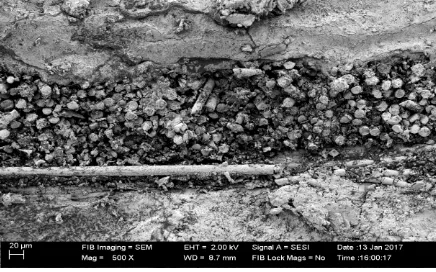2191
Influence on Mechanical Properties of Epoxy Polymer
Matrix Composites reinforced with Surface Treated
Woven Strand Mat E-Glass fibers
Guruprasad H.L1, Dr. J.N. Prakash2
Department of Mechanical Engineering1,2 , East West Institute of Technology1,2, Bangalore-560091 Email: gurugowdahl@gmail.com1 ,prakash69jnp09ace@gmail.com2
Abstract-In the present days composite materials are the popular materials in demand because of their high strength to weight ratio. In the present work an attempt has been made to evaluate the Fiber Surface Treatment of Woven Strand Mat (WSM) E-glass fiber reinforced with Epoxy Polymer Matrix Composites. The hand lay-up technique was used to fabricate the epoxy matrix composites reinforced with treated WSM E-glass fibers of volume fraction of 3.42%. WSM E-glass fibers used to evaluate the mechanical properties of the epoxy composites were treated in three different types. First is the manufacturer supplied E-glass fiber coated with lubricating oil and polyvinyl acetate, second is the surface heat treatment and the last one was Ethyl Silicate coating on heat treated E-glass fibers. Tensile, flexural and impact strength of the composite were determined to study the mechanical properties. The results showed the improvement in mechanical properties of surface treated WSM E-glass fiber reinforced with epoxy polymer matrix composites. The heat treated WSM E-Glass Fibers coated with Ethyl silicate showed the excellent improvement in mechanical properties. Experimental results of mechanical properties for different surface treatment of E-glass fiber were evaluated and compared to conclude.
Index Terms-
Epoxy, Woven strand mat, WSM, E-glass fiber, Mechanical Properties, Composites1. INTRODUCTION
Polymer matrix composites are in great demand as they are the advanced materials with better properties replacing the existing materials. Due to some of the disadvantages with respect to matrix materials, composites are limited to some applications hence creating the need of research to develop the new varieties. Many metals and pure polymer have been replaced my fiber reinforced polymer matrix composites in many applications because of their high strength to weight ratio. The fiber reinforced composites exhibits the excellent mechanical properties which are the most essential parameters to design the long sustainable structures or components [1]. To improve the properties of the composites the use of fillers and reinforcement of fibers are done. This improves the properties like toughness, hardness, stiffness, mould shrinkage and distortion temperature with reduction in processing cost. The organic or inorganic fillers are used to achieve the desired mechanical properties [2].
Glass fibers are the reinforcing materials with polymer matrix composites, they are used in wide range of application from aerospace to circuit boards, as the single fiber of glass with small diameter exhibits the tensile strength of 3.5 GPa [3]. The application of commercially available glass fibers have been limited due to the reduction in the mechanical properties caused by the damages on glass fibers by contact
abrasion between the fibers while handling and humidity degradation [4]. The coupling agent, lubricant and a film former are mixed and applied as a solution or aqueous emulsion is generally called as sizing [5].
To improve the wettability of the fiber surface, the commercially available glass fibers are been surface treated with the liquid resin in the manufacturing process known as sizing [6]. The adequate researches in the direction of surface treatment of glass fiber have been made. Many researchers have been reported with increase in strength by 90% with the fiber surface treatment. This increase in strength is due to sizing, which protects the fiber from contact abrasion and improves the load transferring capability between the matrix and fibers [7,8]. The increase in the strength of glass fibers are dependent on the type of surface treatment, gauge length of fibers, fiber diameter and strain rate [9,10].
2192 and matrix material [13]. The fiber reinforced polymer
composites are the important materials in structural applications. Interdisciplinary applications of FRP’s have leaded the research diversity. Improvements of the mechanical properties are still in progress by the researchers for different applications [14]. In this present investigation an attempt has been made to unveil the influences of fiber surface treatment of E-Glass fibers on the tensile, flexural and Impact properties of Epoxy/Treated Woven Strand Mat (WSM) E-Glass fibers Polymer matrix composites.
2. EXPERIMENTAL PROCEDURES
2.1. Materials
Raw materials selected for the present study are as follows.
2.1.1. Matrix Material
The medium viscosity epoxy resin (DGEBA) with trade name as Lapox L-12 is used with curing agent to fabricate the composite laminates. The two bi-components are mixed together to produce the end product of the cured epoxy resin. The application of epoxy resin are in exterior casings, holding things together, encapsulating the materials, coating and potting. Epoxy is having a wide range of applications due to their ability to process under various conditions, low shrinkage, high chemical resistance and high corrosion resistance due to their ability to sustain at high mechanical and thermal loads. Epoxy is a thermoset polymer widely used for the applications with high performance. Epoxy resins generally react with themselves through reaction known as catalytic homo-polymerization.
2.1.2. Curing Agent
The aliphatic amine curing agent known as Triethylene tetra-amine (TETA) of low viscosity of 10-23 mPas at room temperature with trade name as Hardner K-6 is the used as the curing agent. The application of this curing agent is in constructions, where the low viscosity and fast setting at ambient temperature are required. The resin and curing agent are the two bi-products mixed together to produce the end product of the cured epoxy resin.
2.1.3. E-Glass Fibers
In the present investigation, E-glass fibers in Woven Strand mat (WSM) form have been used as the
reinforcing materials with epoxy as the matrix material. Stiffness, electrical resistance, weathering and good strength properties of the E-glass fibers has made them popular in many applications. Due to their ability of high strength to weight ratio they are used in insulators, tapes, PMC and circuit boards. To protect the E-glass fibers from damages due to humidity and surface abrasion, E-glass fibers are coated with polyvinyl acetate (PVA) at the manufacturing stage. In the present work E-glass fibers with volume fraction of 3.42% are used with three treatments, first is the manufacturer supplied polyvinyl acetate treated and the other two surface treatments are discussed in coming sections.
2.1.4. Ethyl Silicate
In the present investigation Ethyl silicate also known as Tetraethyl orthosilicate or Tetraethoxysilane is used as the coating on the heat treated Woven Strand mat E-glass fiber. Ethyl silicate surface coatings are the inorganic coatings, provided to protect the fibers from corrosion when they are exposed to high operating temperature. The film of conductive matrix is formed around the fibers offers the outstanding cathodic protection.
2.2. Surface Treatments of E-Glass Fibers
2.2.1. Heat Treated E-Glass fibers
In the process of manufacturing the E-glass fibers, the fibers are provided with a layer of lubricating oil or polyvinyl acetate. This layer of coating is given to E-glass fibers to protect them from humidity and damages caused due to abrasion. Overall performance of the composite is dependent on these layers of coating. In the present work, these coatings are removed by heating the E-glass fiber at the temperature of 200oC to 300oC. At this high temperature the layers of lubricant are burnt and carbonized. These heat treated WSM E-glass fibers are used as the reinforcement with epoxy matrix for the evaluation of the mechanical properties.
2.2.2. Ethyl Silicate coated Heat Treated E-Glass fibers
2193 silicate. Ethyl silicate coating was provided by dipping
the E-glass fiber in the Ethyl Silicate bath and dried at ambient temperature. Ethyl Silicate coated heat treated E-glass fibers were evaluated to check for the performance of coated fibers over the manufacturer provided coated fibers.
[image:3.595.70.293.221.483.2]2.3. Fabrication of Composites
Table 1. Specimen Details
Composite Specimen
Designation
Vol. Fraction
of Epoxy
(%)
Vol. Fraction of WSM E-glass
fiber (%) Pure Epoxy EPOXY 100 0 Epoxy +
Manufacturer coated WSM E-glass fiber
MTWSM1 96.58 3.42
Epoxy + Heat treated WSM E-glass fiber
HTWSM1 96.58 3.42
Epoxy + Ethyl Silicate coated HT WSM E-glass fiber
ETWSM1 96.58 3.42
The surface treated Woven Strand Mat (WSM) E-glass fibers with volume fraction of 3.42% are used as the reinforcing material with epoxy polymer matrix to fabricate the composite laminates by the simple hand layup technique. The epoxy and hardner K-6 are the two bi-products, mixed at the ratio of 100:10 to form the cured epoxy resin. The epoxy resin is poured in to the mould within its pot life and the laminates of dimension 250 mm x 250 mm x 3 mm are fabricated and the test coupons are cut as per the ASTM standards for the testing.
2.4. Experiments for Mechanical properties
2.4.1. Tensile Test
Tensile strength is the shortened name of Ultimate tensile strength. Tensile strength is the capacity of a material to resist the elongation under the application of load. It is the maximum stress of the material to withstand stretching before breaking. The tensile test is performed to record the engineering stress versus strain. The maximum point in the stress-strain curve is the ultimate tensile strength of the material. The value
of the tensile strength is not dependant on the size of the specimen as it is an intensive property. ASTM D-3039 was the standard method of testing used for tensile testing of polymer matrix composite materials. The tensile test is conducted with the controlled loading at the speed of 5 mm/min. The specimen undergoes the testing with the application of load till it fails.
2.4.2. Flexural Test
Flexural strength is also known as modulus of rupture or bending strength. The three point bending test is usually used to determine the flexural strength of the specimen with circular or rectangular cross-section. The material at its moment of failure experience the maximum stress within itself is the flexural strength of the material. In the flexural test the inner fibers experience lesser stress when compared with the outer fibers. ASTM E-190-14 is the standard testing procedure to determine the flexural strength of the polymer matrix composite. The specimen is supported between the two supports with the span length of 50 mm and at the centre of the specimen the load is applied.
2.4.3. Impact Test
The Charpy impact test also known as Charpy V-notch test, is a high strain rate test used to determine the energy absorption of the material during failure. Charpy test is most commonly used on metals, polymers, ceramics and composites. The low strength materials without fracture mode show high impact energy absorption and they are insensitive to temperature. Impact energy is defined as the work done to fracture the specimen. The specimen will absorb the energy until it yields, when the striker hits the specimen, but the fracture occurs only when the specimen cannot absorb any more further energy. ASTM D-6110 is the standard testing procedure used to evaluate the impact strength of the polymer matrix composites.
3. RESULTS & DISCUSSION
3.1. Tensile Strength
2194 showed the maximum strength when compared with
[image:4.595.74.291.295.538.2]manufacturer supplied polyvinyl acetate (PVA) coated E-glass fiber laminates, this is due the removal of coatings provide by the manufacturer which leaded to improvement in adhesion between the fibers and the matrix material at the interface. But the fibers cannot be used without coating in the applications because they may get damaged due to abrasion and humidity. Hence heat treated WSM E-glass fibers are provided with Ethyl Silicate coated. Ethyl Silicate coated Heat treated WSM E-glass fiber reinforced laminates have shown the next level of strength when compared with manufacturer supplied E-glass fiber laminates. Table 2. Tensile properties of Epoxy/Treated WSM
E-Glass fiber PMC’s Specimen
Designation
Ultimate Tensile Strength in MPa
EPOXY 64.32
MTWSM1 97.76
HTWSM1 147.93
[image:4.595.311.523.438.742.2]ETWSM1 123.49
Fig. 1. Tensile Strength of Epoxy/Treated WSM E-Glass PMC’s.
Fig. 2: Tensile Strength v/s % Elongation of Epoxy/Treated WSM E-Glass PMC’s.
3.2. Flexural Strength
The flexural strength of the Treated Woven Strand Mat reinforced epoxy matrix composites are shown in Figure 3. The plain epoxy has shown the lowest flexural strength due to the absent of E-glass fibers. The heat treated WSM E-glass fiber reinforced laminates showed the maximum flexural strength when compared with manufacturer supplied polyvinyl acetate (PVA) coated E-glass fiber laminates. The heat treated WSM E-glass fibers are provided with Ethyl Silicate coating as the fibers cannot be used without coating in the applications because they may get damaged due to abrasion and humidity. These Ethyl Silicate coated Heat treated WSM E-glass fiber reinforced laminates have shown the next level of strength when compared with manufacturer supplied E-glass fiber laminates. This is due to the removal of coatings provided by the manufacturer and coating the fibers with Ethyl Silicate which improved the adhesion between the fibers and the matrix material at the interface. Heat treatment followed by Ethyl Silicate coating exhibited the good strength compared with manufacturer supplied E-glass fiber.
Table 3. Flexural properties of Epoxy/Treated WSM E-Glass fiber PMC’s
Specimen
Designation Flexural Strength in MPa
EPOXY 27.78
MTWSM1 55.56
HTWSM1 69.45
ETWSM1 59.17
[image:4.595.80.285.579.724.2]2195 Fig. 4. Flexural Strength v/s Displacement
Epoxy/Treated WSM E-Glass PMC’s
[image:5.595.308.530.240.740.2]3.3. Impact Strength
Table 4. Impact Strength of Epoxy/Treated WSM E-Glass fiber PMC’s
Specimen
Designation Impact Strength in J
EPOXY 17.5
MTWSM1 19
HTWSM1 21
ETWSM1 20
Fig. 5. Impact Energy absorption of Epoxy/Treated WSM E-Glass PMC’s
The impact energy absorbed by the Treated Woven Strand Mat reinforced Epoxy matrix composites have been shown in Figure 5. The plain epoxy has shown the least absorption of impact energy due to the absent of E-glass fibers. The heat treated WSM E-glass fiber reinforced laminates showed the maximum impact energy absorbed when compared with manufacturer supplied polyvinyl acetate (PVA) coated E-glass fiber laminates. The Ethyl Silicate coated Heat treated WSM E-glass fiber reinforced laminates have shown
the next level of impact energy absorbed when compared with manufacturer supplied E-glass fiber laminates. This is due to the removal of coatings provided by the manufacturer and coating the fibers with Ethyl Silicate which improved the adhesion between the fibers and the matrix material at the interface. Heat treatment followed by Ethyl Silicate coating exhibited the more strength compared with manufacturer supplied E-glass fiber.
4. SCANNING ELECTRON MICROSCOPE
ANALYSIS
Fig. 6. Epoxy
Fig. 7: MTWSM1
[image:5.595.74.290.359.599.2]2196 Fig. 9: ETWSM1
The SEM shows the bonding of the treated E-glass fibers and the epoxy resin. It can be observed in Figure-8 that the heat treated E-glass fibers exhibited an excellent interface bonding, resulting in excellent transmission of stress from epoxy resin to treated E-glass fibers resulting in excellent mechanical properties. From Figure-9 it is observed that Ethyl Silicate coated Heat treated E-glass fibers have a better interfacial bonding capability than the manufacture supplied coating as seen in figure-7, hence the Ethyl Silicate coated Heat treated E-glass fibers reinforced epoxy polymer matrix composites exhibited the better mechanical properties then the manufacture supplied coating.
5. CONCLUSIONS
The experimental evaluation of the influence of Treated Woven Strand Mat E-glass fiber used as reinforcement with Epoxy polymer matrix composites has been concluded as follows:
Surface treatment of the E-glass fibers is enhancing the tensile, flexural and impact strength of the composites when compared with manufacturer supplied E-glass fiber.
Heat treated WSM E-glass fibers reinforcing with epoxy matrix is increasing the mechanical properties of the composites at the expense of fiber surface damages caused by abrasion.
The removal of coatings provided by the manufacturer and coating the fibers with Ethyl Silicate is improving the adhesion at the region of fiber/matrix interface.
SEM resuls shows the better donding of the resin and fibers, resulting in the enhanced stress transmission between them.
The work concludes that by E-glass fibers treated with Ethyl Silicate, the mechanical properties of the composites can be enhanced.
REFERENCES
[1] A. Yasmin and I. M. Daniel. 2004. Mechanical and Thermal Properties of Graphite Platelet/Epoxy Composites. Polymer. Vol. 45. 24. 8211-8219.
[2] Guruprasad.H.L, Dr. J.N.Prakash. August-2018. Influence of Ca2SiO4 as fillers on Mechanical Properties of Epoxy Polymer Matrix Composites. International Journal of Engineering research and Technology. ISSN: 2278-0181. Vol. 7. 08. 99-102.
[3] E.N. Brown, A.K. Davis, K.D. Jonnalagadda, N.R. Sottos. 2005. Effect of surface treatment on the hydrolytic stability of E-glass fiber bundle tensile strength. Composites Science and Technology. Vol. 65. 129-136.
[4] Spaude R. 1987. Corrosion phenomena in glass fibers and glass fiber reinforced polymers. International Journal of Material Product Technology. Vol.2. 247-257.
[5] Jones FR. 1996. Interphase formation and control in fibre composite materials. Key Engineering Materials. 116. 41-60.
[6] Schutte CL. 1994. Environmental durability of glass-fiber composites. Material Science Engineering Rep. Vol. 13(7). 265–323.
[7] Thomas WF. 1971. An investigation of the factors affecting the strength of glass fiber strand. Glass Technology. 12(3). 60-64.
[8] Thomas WF. 1972. An investigation of the factors affecting the strength of glass fiber strand. Part 2. Glass Technology. 13(1). 17-21.
[9] Thomas WF. 1972. An investigation of the factors affecting the strength of glass fiber strand, the strength in polyester resin. Glass Technology. 13(4). 122-125.
[10]Thomas WF. 1972. An investigation of the factors affecting the strength of glass fiber strand. Part 4. The effect of fiber surface area. Glass Technology. 13(5). 141–144.
[11]A.T. DiBenedetto. 1985. Evaluation of fiber surface treatments in composite materials. Pure & Applied Chemistry. Vol. 57. 11. 1659-1665. [12]Guruprasad.H.L, Kiran Kumar.S, Dr. J.N.
Prakash. Dec-2017. Mechanical Characterization of Epoxy/Heat Treated Glass Fiber and CaSiO3 Based Polymer Matrix Composite. International Journal of Advanced Research in Education & Technology. Vol. 4. 4.
[13]P.W. Erickson. 1970. Proceedings 25th Annual Technical Conference. Reinforced Plastics Division. SPI. Section 13-A.



